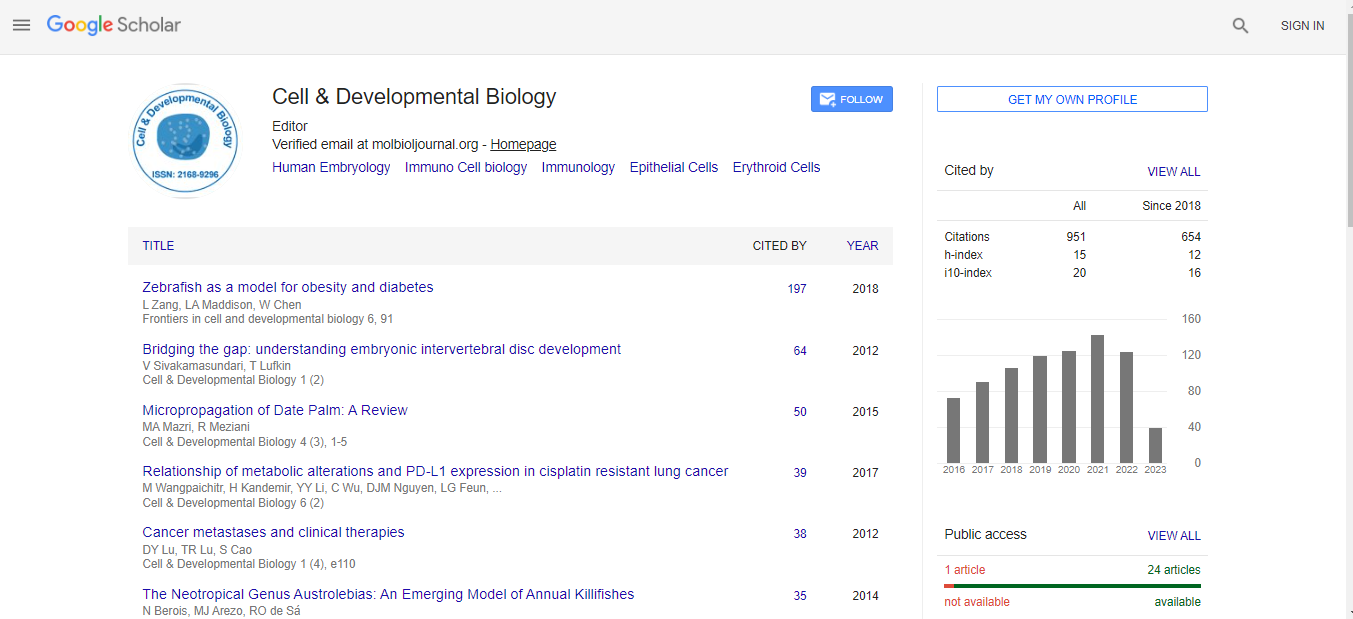Cell & Developmental Biology : Citations & Metrics Report
Articles published in Cell & Developmental Biology have been cited by esteemed scholars and scientists all around the world. Cell & Developmental Biology has got h-index 15, which means every article in Cell & Developmental Biology has got 15 average citations.
Following are the list of articles that have cited the articles published in Cell & Developmental Biology.
| 2022 | 2021 | 2020 | 2019 | 2018 | |
|---|---|---|---|---|---|
Total published articles |
29 | 30 | 26 | 5 | 8 |
Conference proceedings |
0 | 0 | 0 | 0 | 0 |
Citations received as per Google Scholar, other indexing platforms and portals |
123 | 142 | 124 | 118 | 105 |
| Journal total citations count | 951 |
| Journal impact factor | 5.1 |
| Journal 5 years impact factor | 6.8 |
| Journal cite score | 7.0 |
| Journal h-index | 15 |
| Journal h-index since 2019 | 12 |
Important citations (614)
Natoli r, mason e, jiao h, chuah a, patel h, fernando n, valter k, wells ca, provis j, rutar m. dynamic interplay of innate and adaptive immunity during sterile retinal inflammation: insights from the transcriptome. frontiers in immunology. 2018;9:1666. |
|
Xu d, liu a, wang x, zhang m, zhang z, tan z, qiu m. identifying suitable reference genes for developing and injured mouse cns tissues. developmental neurobiology. 2018 jan;78(1):39-50. |
|
Korbolina ee, ershov ni, bryzgalov lo, kolosova ng. application of quantitative trait locus mapping and transcriptomics to studies of the senescence-accelerated phenotype in rats. bmc genomics. 2014 dec;15(12):s3.https://bmcgenomics.biomedcentral.com/articles/10.1186/1471-2164-15-s12-s3 |
|
Uren pj, lee jt, doroudchi mm, smith ad, horsager a. a profile of transcriptomic changes in the rd10 mouse model of retinitis pigmentosa. molecular vision. 2014;20:1612. |
|
Prenafeta claramunt n. estudio de los factores pronóstico de las metástasis pulmonares de cáncer colorectal. |
|
No p, profile c. university faculty details page on du web-site. statistics. 2014 jan;62:55. |
|
Sree ks, rajam mv. genetic engineering strategies for biotic stress tolerance in plants. inplant biology and biotechnology 2015 (pp. 611-622). springer, new delhi. |
|
Yogindran s, ghosh a, rajam mv. artificial mirnas for specific gene silencing and engineering virus resistance in plants. cell development biology. 2015;4:e137. |
|
Pareek m, yogindran s, mukherjee sk, rajam mv. plant micrornas: biogenesis, functions, and applications. inplant biology and biotechnology 2015 (pp. 639-661). springer, new delhi. |
|
Degani e. morfologia do primeiro estágio juvenil de quatro espécies de caranguejos leucosioidea (crustacea: decapoda: brachyura), com proposta de padronização para as descrições dos estágios iniciais em decapoda. |
|
Hartnoll r. in remembrance of donald williamson (6 january 1922-29 january 2016), planktologist, carcinologist, and evolutionist: a metamorphosis. journal of crustacean biology. 2016 may 1;36(3):408-13. |
|
Rees c. nature's calendar: a year in the life of a wildlife sanctuary. johns hopkins university press; 2019 apr 2. |
|
Mondal p. origin of caterpillars: distant hybridization vs. descent with common ancestry. |
|
Matthews jb, matthews jr. ocean surface warming part 2: isle of man daily surface timeseries 1904-2012, arctic basal ice melt, sunspots, and ocean warming. ocean sci. discuss. 2013. |
|
Williamson di. larvae, lophophores and chimeras in classification. cell dev biol. 2013;2(128):2. |
|
Lereis lm. estudios de senescencia funcional en la mosca plaga ceratitis capitata. |
|
Yadav r, chanu si, raj k, sarkar s. drosophila melanogaster: a prime experimental model system for aging studies. intopics in biomedical gerontology 2017 (pp. 3-33). springer, singapore. |
|
Chanu si, singh md, yadav r, raj k, sarkar s. neurodegeneration and ageing: a fatal encounter. cell dev biol 2: 119. doi: 10.4172/2168-9296.1000119 page 2 of 13 aging & neurodegeneration volume 2• issue 2• 1000119 cell dev biol issn: 2168-9296 cdb, an open access journal of function mutation leads to embryonic lethality in mouse. it has also been suggested to be involved in cellular trafficking and vesicular transport. spinocerebellar ataxia type 3 (sca3) is the most common form of ataxia and is caused by mutation of ataxin 3 located on 14q24. 3-32 .... |
|
Hussin m, abdul hamid a, abas f, ramli ns, jaafar ah, roowi s, abdul majid n, pak dek ms. nmr-based metabolomics profiling for radical scavenging and anti-aging properties of selected herbs. molecules. 2019 jan;24(17):3208. |
|
Chanu si, singh md, yadav r, raj k, sarkar s. neurodegeneration an d ageing: a fatal encounter. cell dev biol s. 2013;1:2. |
|

